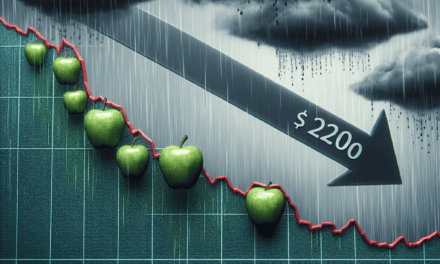“Steady Leadership Amidst Economic Shifts: Powell Stands Firm as Fed Cuts Rates”
Introduction
In a significant move reflecting ongoing economic uncertainties, the Federal Reserve has announced a reduction in interest rates, aiming to bolster economic growth amid global trade tensions and domestic challenges. This decision comes amidst heightened scrutiny and pressure from political figures, notably President Donald Trump, who has been vocal in his criticism of the Fed’s monetary policies. Despite this pressure, Federal Reserve Chairman Jerome Powell has firmly stated his intention to remain in his position, emphasizing the independence of the central bank and his commitment to its mandate. Powell’s stance underscores the importance of maintaining a non-partisan approach to monetary policy, even in the face of external political pressures.
Impact Of Fed’s Rate Cut On The Economy
The recent decision by the Federal Reserve to lower interest rates marks a significant moment in the ongoing efforts to sustain economic growth amid global uncertainties. This move, aimed at stimulating economic activity, comes at a time when trade tensions and geopolitical risks have cast a shadow over the global economic outlook. By reducing the cost of borrowing, the Fed seeks to encourage both consumer spending and business investment, which are critical components of economic expansion. Lower interest rates typically lead to cheaper loans for consumers and businesses, potentially boosting sectors such as housing, automotive, and capital investments. Consequently, this can lead to increased production, job creation, and overall economic growth.
However, the decision to cut rates is not without its critics. Some economists argue that the U.S. economy, which has been experiencing steady growth and low unemployment, does not require additional monetary stimulus. They caution that lowering rates could lead to overheating in certain sectors, potentially inflating asset bubbles. Moreover, with interest rates already at historically low levels, the Fed has limited room to maneuver should a more severe economic downturn occur. This raises concerns about the long-term efficacy of monetary policy as a tool for economic stabilization.
In addition to the economic implications, the Fed’s rate cut has also sparked political debate. President Donald Trump has been vocal in his criticism of the Federal Reserve, frequently calling for more aggressive rate cuts to bolster economic growth. This has led to speculation about the independence of the Fed and its Chairman, Jerome Powell. Despite the pressure, Powell has maintained that the Fed’s decisions are based on economic data and analysis, rather than political considerations. In a recent statement, Powell emphasized his commitment to serving his full term, regardless of any external pressures to resign.
The interplay between monetary policy and political influence is a delicate balance. The Federal Reserve’s independence is crucial for maintaining credibility and ensuring that economic decisions are made in the best interest of the country, free from short-term political agendas. Powell’s stance underscores the importance of this independence, as it allows the Fed to focus on its dual mandate of promoting maximum employment and stable prices.
As the economy navigates through these uncertain times, the impact of the Fed’s rate cut will be closely monitored. Financial markets, which often react swiftly to changes in monetary policy, have already shown signs of volatility. Investors are weighing the potential benefits of lower rates against the risks of a slowing global economy. Meanwhile, businesses and consumers are likely to reassess their borrowing and spending plans in light of the new interest rate environment.
In conclusion, the Federal Reserve’s decision to lower interest rates is a strategic move aimed at sustaining economic growth amid a backdrop of global uncertainties. While it offers potential benefits in terms of stimulating spending and investment, it also raises questions about the long-term implications for monetary policy and economic stability. As Chairman Powell navigates these challenges, his commitment to maintaining the Fed’s independence remains a pivotal factor in ensuring that economic decisions are made with a focus on data-driven analysis rather than political influence. The coming months will reveal the true impact of this rate cut on the U.S. economy and its ability to weather external pressures.
Powell’s Stance: Independence Of The Federal Reserve
In a significant move that has captured the attention of both financial markets and political analysts, the Federal Reserve recently announced a reduction in interest rates, a decision that underscores its commitment to supporting economic growth amid global uncertainties. This decision, however, has not been without controversy, particularly in the context of President Donald Trump’s frequent criticisms of the Federal Reserve’s policies. Despite the political pressure, Federal Reserve Chairman Jerome Powell has made it clear that he intends to maintain the independence of the central bank, emphasizing that he will not resign if pressured by the President.
The Federal Reserve’s decision to lower interest rates is primarily aimed at sustaining the longest economic expansion in U.S. history. By reducing borrowing costs, the Fed hopes to encourage consumer spending and business investment, thereby bolstering economic activity. This move comes at a time when trade tensions and a slowing global economy pose potential risks to the U.S. economic outlook. The rate cut is seen as a preemptive measure to mitigate these risks and ensure that the economy remains on a stable growth path.
However, the decision has not been without its critics. President Trump has been vocal in his dissatisfaction with the Federal Reserve, often calling for more aggressive rate cuts to stimulate the economy further. He has argued that higher interest rates have hindered economic growth and placed the U.S. at a competitive disadvantage compared to other countries with lower rates. Despite these criticisms, Powell has consistently defended the Fed’s actions, asserting that decisions are made based on economic data and analysis rather than political considerations.
Powell’s stance on maintaining the Federal Reserve’s independence is crucial in preserving the credibility and effectiveness of the institution. Central bank independence is widely regarded as essential for ensuring that monetary policy decisions are made in the best interest of the economy, free from short-term political pressures. Powell has reiterated his commitment to this principle, stating unequivocally that he would not step down if asked to do so by President Trump. This declaration serves as a reaffirmation of the Fed’s autonomy and its dedication to its dual mandate of promoting maximum employment and stable prices.
Moreover, Powell’s resolve to uphold the Fed’s independence is supported by historical precedent. Previous Fed chairs have also faced political pressure but have maintained the institution’s autonomy. This tradition of independence has been instrumental in fostering a stable economic environment, allowing the Fed to respond effectively to various economic challenges over the years.
In conclusion, the Federal Reserve’s recent rate cut and Powell’s firm stance on independence highlight the delicate balance between economic policy and political influence. While the rate cut aims to support continued economic growth, Powell’s commitment to the Fed’s autonomy underscores the importance of maintaining a non-partisan approach to monetary policy. As the U.S. navigates an increasingly complex economic landscape, the independence of the Federal Reserve remains a cornerstone of its ability to make sound policy decisions that benefit the broader economy. Powell’s leadership in this regard is a testament to the enduring value of central bank independence in promoting economic stability and prosperity.
Historical Context: Fed Rate Cuts And Presidential Pressure
The Federal Reserve’s decision to lower interest rates has often been a focal point of economic policy, reflecting the institution’s mandate to foster maximum employment and stable prices. Historically, the Fed’s rate cuts have been employed as a tool to stimulate economic growth during periods of sluggish economic activity or to counteract potential downturns. This monetary policy approach is not new; it has been a recurring theme in the Fed’s strategy to navigate the complex dynamics of the U.S. economy. However, the intersection of monetary policy and political pressure adds a layer of complexity to the Fed’s decision-making process, as evidenced by recent events involving Fed Chair Jerome Powell and former President Donald Trump.
In the context of historical precedents, the Federal Reserve has often faced pressure from the executive branch, particularly during times of economic uncertainty. For instance, during the 1970s, President Richard Nixon famously pressured then-Fed Chair Arthur Burns to maintain low interest rates to support his re-election campaign. This historical backdrop provides a lens through which to view the contemporary scenario involving Powell and Trump. The Fed’s recent decision to lower rates, while primarily driven by economic indicators, has also been scrutinized for its potential political implications.
Jerome Powell, appointed by Trump in 2018, has maintained a stance of independence, emphasizing the Fed’s commitment to data-driven decision-making. Despite this, Trump frequently criticized Powell for not lowering rates quickly enough, arguing that higher rates were hindering economic growth. This tension between the Fed and the White House is not unprecedented, yet it underscores the delicate balance the Fed must maintain between responding to economic conditions and resisting political influence.
In light of these dynamics, Powell’s recent statement that he would not resign if pressured by Trump is significant. It reaffirms the Fed’s independence, a cornerstone of its credibility and effectiveness. The ability of the Fed to operate without political interference is crucial for maintaining market confidence and ensuring that monetary policy decisions are made in the best interest of the economy, rather than being swayed by short-term political considerations.
Moreover, Powell’s stance highlights the broader implications of political pressure on central banks globally. In many countries, central banks have faced similar challenges, where political leaders have sought to influence monetary policy to align with their economic agendas. The independence of central banks is a fundamental principle that supports their role in stabilizing economies and preventing inflationary pressures.
As the Fed continues to navigate the complexities of the current economic landscape, the historical context of rate cuts and presidential pressure serves as a reminder of the challenges inherent in maintaining an independent monetary policy. The Fed’s actions, while primarily focused on economic indicators, are inevitably viewed through a political lens, making the institution’s independence all the more critical.
In conclusion, the interplay between the Federal Reserve’s rate cuts and presidential pressure is a recurring theme in U.S. economic history. Jerome Powell’s commitment to maintaining the Fed’s independence, despite external pressures, underscores the importance of this principle in ensuring effective monetary policy. As the Fed moves forward, its ability to remain insulated from political influence will be essential in navigating future economic challenges and maintaining the stability of the U.S. economy.
Market Reactions To The Fed’s Decision
The recent decision by the Federal Reserve to lower interest rates has sent ripples through the financial markets, prompting a variety of reactions from investors, analysts, and policymakers alike. This move, aimed at sustaining economic growth amid global uncertainties, has been met with both optimism and skepticism. As the markets digest the implications of this decision, Federal Reserve Chairman Jerome Powell’s stance on maintaining his position, even if pressured by President Trump to resign, adds another layer of complexity to the unfolding economic narrative.
Initially, the reduction in interest rates was anticipated by many market participants, who had been closely monitoring signals from the Federal Reserve. The decision to cut rates is seen as a proactive measure to counteract potential economic slowdowns, particularly those stemming from trade tensions and slowing global growth. In response, stock markets experienced a surge, with investors buoyed by the prospect of cheaper borrowing costs and the potential for increased consumer spending. This optimism, however, is tempered by concerns over whether the rate cut will be sufficient to address underlying economic challenges.
Moreover, the bond markets have reacted with a degree of caution. While lower interest rates typically lead to a decrease in bond yields, the current environment of uncertainty has led to a more complex response. Investors are weighing the benefits of lower rates against the risks of prolonged economic instability. Consequently, there has been a mixed reaction in the bond markets, with some investors seeking the safety of government bonds, while others are exploring higher-yielding alternatives.
In the currency markets, the Federal Reserve’s decision has exerted downward pressure on the U.S. dollar. A lower interest rate environment generally makes a currency less attractive to investors seeking higher returns, leading to a depreciation of the dollar against other major currencies. This shift has implications for international trade, as a weaker dollar can make U.S. exports more competitive, potentially providing a boost to American manufacturers. However, it also raises concerns about the impact on import prices and inflation.
Amid these market reactions, Jerome Powell’s firm stance on his role as Federal Reserve Chairman has garnered significant attention. Despite President Trump’s previous criticisms and suggestions that Powell should resign, the Chairman has made it clear that he intends to fulfill his term. This assertion of independence is crucial for maintaining the credibility and autonomy of the Federal Reserve, which is essential for effective monetary policy. Powell’s commitment to his position underscores the importance of a stable and independent central bank, particularly in times of economic uncertainty.
As the markets continue to adjust to the Federal Reserve’s decision, the interplay between monetary policy and political dynamics remains a focal point for investors and analysts. The rate cut, while providing short-term relief, raises questions about the long-term trajectory of the U.S. economy and the tools available to policymakers. Furthermore, Powell’s determination to remain in his role highlights the ongoing tension between the Federal Reserve and the executive branch, a dynamic that could influence future policy decisions.
In conclusion, the Federal Reserve’s decision to lower interest rates has elicited a range of responses across financial markets, reflecting both optimism and caution. As investors navigate this evolving landscape, the steadfastness of Jerome Powell in the face of political pressure serves as a reminder of the critical role that central bank independence plays in shaping economic outcomes. The coming months will be pivotal in determining how these factors converge to influence the broader economic environment.
The Role Of The Federal Reserve In Economic Stability
The Federal Reserve, often referred to simply as the Fed, plays a pivotal role in maintaining economic stability in the United States. As the central bank of the nation, its primary objectives include managing inflation, maximizing employment, and moderating long-term interest rates. These goals are achieved through various monetary policy tools, with the adjustment of interest rates being one of the most significant. Recently, the Fed made headlines by lowering interest rates, a decision that underscores its commitment to fostering economic growth and stability.
Lowering interest rates is a strategic move often employed by the Fed to stimulate economic activity. By reducing the cost of borrowing, businesses are encouraged to invest in expansion, and consumers are more likely to spend, both of which can lead to job creation and economic growth. This decision comes at a time when global economic uncertainties and domestic challenges necessitate a proactive approach to safeguarding the U.S. economy. The Fed’s decision to lower rates is not made lightly; it involves careful consideration of various economic indicators and forecasts.
However, the Fed’s actions do not occur in a vacuum. They are often subject to scrutiny and pressure from various quarters, including political figures. In recent times, President Donald Trump has been vocal about his dissatisfaction with the Fed’s monetary policy, particularly its interest rate decisions. He has publicly criticized the Fed and its Chairman, Jerome Powell, urging for more aggressive rate cuts to bolster economic growth. Despite this pressure, Powell has maintained the Fed’s independence, emphasizing that decisions are made based on economic data and not political influence.
In a recent development, Powell was asked whether he would resign if pressured by President Trump to do so. His response was unequivocal; he stated that he would not resign, reinforcing the principle that the Federal Reserve operates independently of political pressures. This stance is crucial for maintaining the credibility and effectiveness of the Fed. An independent central bank is better positioned to make decisions that are in the best long-term interest of the economy, free from short-term political considerations.
The independence of the Federal Reserve is a cornerstone of its ability to manage the economy effectively. It allows the Fed to take necessary actions, even if they are unpopular, to ensure economic stability. This independence is not just a matter of tradition but is enshrined in the structure of the Federal Reserve System itself. The Fed’s decisions are guided by economic data and analysis, and its leaders are appointed for terms that do not coincide with the political election cycle, further insulating them from political pressures.
In conclusion, the Federal Reserve’s recent decision to lower interest rates highlights its ongoing role in promoting economic stability. While political pressures are an inevitable part of the landscape, the Fed’s commitment to its mandate and its independence are vital for its effectiveness. Chairman Jerome Powell’s refusal to resign under political pressure is a testament to the Fed’s dedication to making decisions based on economic realities rather than political expediency. As the U.S. economy navigates through uncertain times, the role of the Federal Reserve remains as crucial as ever in ensuring a stable and prosperous economic future.
Analyzing Trump’s Influence On Monetary Policy
In a significant move that has captured the attention of both economists and political analysts, the Federal Reserve recently decided to lower interest rates, a decision that has sparked widespread discussion about the influence of political figures on monetary policy. This decision comes amidst a backdrop of persistent pressure from President Donald Trump, who has been vocal in his criticism of the Federal Reserve’s previous rate hikes. Trump’s calls for lower rates have been consistent, arguing that such a move would bolster economic growth and maintain the United States’ competitive edge in the global market. However, the implications of this decision extend beyond mere economic considerations, raising questions about the independence of the Federal Reserve and the potential impact of political influence on its decision-making processes.
Jerome Powell, the current Chair of the Federal Reserve, has found himself at the center of this debate. Despite the rate cut aligning with Trump’s demands, Powell has maintained that the decision was based on economic indicators and not political pressure. In a recent press conference, Powell emphasized the Fed’s commitment to its dual mandate of promoting maximum employment and stabilizing prices, asserting that the rate cut was a proactive measure to sustain the economic expansion in the face of global uncertainties. Furthermore, Powell has made it clear that he has no intention of resigning, even if pressured by President Trump, underscoring his dedication to maintaining the Fed’s independence.
The relationship between the Federal Reserve and the executive branch has historically been one of careful balance, with the Fed operating as an independent entity to ensure that monetary policy decisions are made based on economic data rather than political agendas. However, Trump’s unprecedented public criticism of the Fed and its leadership has challenged this dynamic, leading to concerns about the potential erosion of the Fed’s autonomy. Critics argue that succumbing to political pressure could undermine the credibility of the Federal Reserve, potentially leading to adverse long-term economic consequences.
On the other hand, some analysts suggest that the rate cut was a necessary response to evolving economic conditions, including trade tensions and slowing global growth. They argue that the Fed’s decision aligns with its mandate and that any alignment with Trump’s preferences is coincidental rather than indicative of undue influence. This perspective highlights the complexity of monetary policy, where decisions must balance domestic economic indicators with international developments.
As the debate continues, it is essential to consider the broader implications of political influence on monetary policy. The Federal Reserve’s independence is a cornerstone of its ability to manage the economy effectively, and any perceived encroachment by political figures could have significant ramifications. While the current situation has brought these issues to the forefront, it also serves as a reminder of the importance of safeguarding the Fed’s autonomy to ensure that monetary policy remains focused on long-term economic stability rather than short-term political gains.
In conclusion, the recent rate cut by the Federal Reserve and Powell’s firm stance against resignation highlight the ongoing tension between political influence and monetary policy independence. As the economic landscape continues to evolve, maintaining the delicate balance between these forces will be crucial in ensuring that the Federal Reserve can effectively fulfill its mandate without compromising its integrity. The outcome of this dynamic will undoubtedly shape the future of monetary policy in the United States, with implications that extend far beyond the current administration.
Future Implications Of The Fed’s Rate Adjustment
The recent decision by the Federal Reserve to lower interest rates has sparked considerable discussion regarding its future implications on the economy. This move, aimed at sustaining economic growth amidst global uncertainties, reflects the Fed’s proactive approach to monetary policy. By reducing rates, the Federal Reserve seeks to encourage borrowing and investment, thereby stimulating economic activity. However, this decision also raises questions about the long-term effects on inflation, consumer spending, and financial markets.
In the short term, lower interest rates are likely to benefit consumers and businesses by reducing the cost of borrowing. This can lead to increased spending on goods and services, as well as greater investment in business expansion. Consequently, these activities can contribute to job creation and economic growth. Moreover, lower rates can also provide relief to those with existing debt, as they may experience reduced interest payments, thereby increasing disposable income.
Nevertheless, the decision to lower rates is not without its potential drawbacks. One concern is the risk of inflation. While moderate inflation is generally considered a sign of a healthy economy, excessively low rates over an extended period can lead to overheating, where demand outpaces supply, causing prices to rise rapidly. This scenario could erode purchasing power and necessitate future rate hikes, which might stifle economic growth.
Furthermore, the Fed’s decision comes at a time of heightened political scrutiny. President Donald Trump has been vocal in his criticism of the Federal Reserve, advocating for more aggressive rate cuts to bolster economic performance. In this context, Federal Reserve Chairman Jerome Powell’s recent statement that he would not resign if pressured by Trump underscores the importance of maintaining the Fed’s independence. Powell’s stance highlights the delicate balance the Fed must strike between responding to economic indicators and resisting political pressures that could undermine its credibility.
The implications of the Fed’s rate adjustment extend beyond domestic borders. In a globalized economy, changes in U.S. monetary policy can have ripple effects worldwide. Lower U.S. interest rates may lead to a weaker dollar, which can impact international trade by making American exports more competitive while increasing the cost of imports. Additionally, other central banks may feel compelled to adjust their own monetary policies in response, potentially leading to a global trend of rate cuts.
Financial markets are also likely to react to the Fed’s decision. Historically, lower interest rates have been associated with rising stock prices, as investors seek higher returns in equities compared to low-yielding bonds. However, market volatility can increase if investors perceive the rate cut as a signal of underlying economic weakness. Therefore, while the initial response may be positive, sustained market confidence will depend on broader economic indicators and corporate earnings.
In conclusion, the Federal Reserve’s decision to lower interest rates is a strategic move aimed at supporting economic growth in uncertain times. While it offers immediate benefits in terms of reduced borrowing costs and potential economic stimulation, it also presents challenges such as inflation risks and political pressures. The global implications of this decision further complicate the landscape, affecting trade dynamics and international monetary policies. As such, the Fed’s actions will require careful monitoring and adjustment to ensure that the intended outcomes are achieved without unintended consequences.
Q&A
1. **What action did the Federal Reserve take regarding interest rates?**
The Federal Reserve lowered interest rates.
2. **Who is the Chairman of the Federal Reserve mentioned in the context?**
Jerome Powell.
3. **What was President Trump’s stance towards the Federal Reserve’s decision?**
President Trump had been pressuring the Federal Reserve to lower interest rates further.
4. **Did Jerome Powell indicate any intention to resign if pressured by President Trump?**
No, Jerome Powell declined to resign if pressured by President Trump.
5. **What is the primary reason for the Federal Reserve to lower interest rates?**
The primary reason is typically to stimulate economic growth by making borrowing cheaper.
6. **How does lowering interest rates affect the economy?**
Lowering interest rates generally encourages borrowing and investing, which can boost economic activity.
7. **What is the potential impact of political pressure on the Federal Reserve’s decisions?**
Political pressure can undermine the Federal Reserve’s independence, potentially leading to decisions that are not based on economic data or conditions.
Conclusion
The Federal Reserve’s decision to lower interest rates reflects its commitment to supporting economic growth amid potential challenges. Despite external pressures, including from political figures like former President Trump, Fed Chair Jerome Powell’s refusal to resign underscores the importance of maintaining the central bank’s independence. This stance is crucial for ensuring that monetary policy decisions are made based on economic indicators rather than political influence, thereby preserving the credibility and effectiveness of the Federal Reserve in managing the economy.





